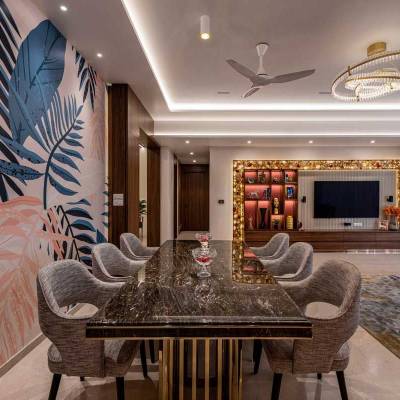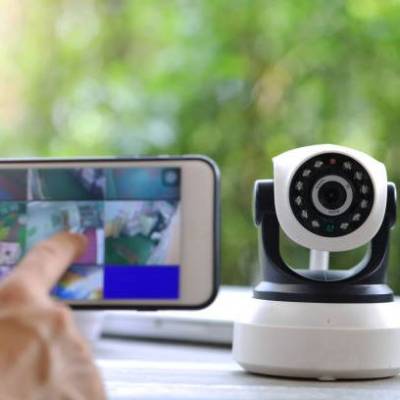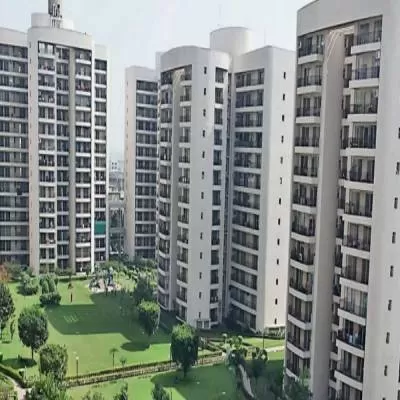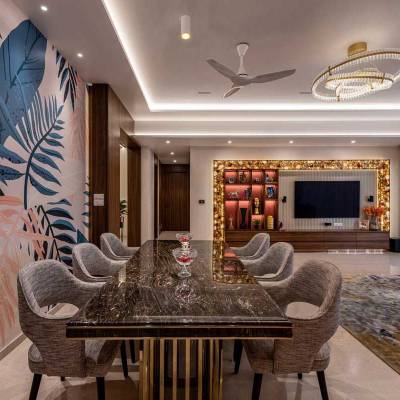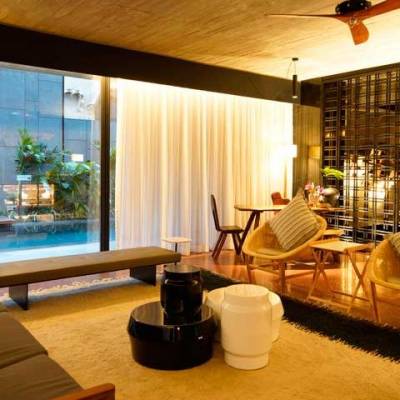- Home
- Real Estate
- What trends are driving demand in the smart homes space?
What trends are driving demand in the smart homes space?
Smart homes use Internet-connected devices to enable remote monitoring and management of appliances and systems. In fact, home automation is increasingly being considered a necessity than a luxury, with safety, security and energy-efficiency as imperatives. Today’s smart homes feature TVs, lighting systems, thermostats, locks, security cameras, kitchen appliances and household system monitors—which are all smart!
Globally, the smart home appliances market is expected to grow at about 32 per cent CAGR during 2019-2025. What’s more, the Asia Pacific region is expected to witness the fastest growth rate in this period, considering the increase in the number of home appliances vendors in this region. In India, the home automation market currently stands at $ 1.6 billion and is estimated to reach $ 7.2 billion by 2023. It is dominated by smart appliances, security systems, lighting and controls, and energy management.
Trending features
In India, technologies like motion-sensing cameras, smart alarms and video door monitoring systems have been highly popular. According to Ashish R Puravankara, Managing Director, Puravankara, “We have also noticed that plug-and-play, voice-controlled devices like Google Home and similar devices have gained greater acceptance among homebuyers who are now looking to convert their living spaces into voice-enabled smart homes.”
Agreeing that voice assistants like Google Home and Amazon Alexa are becoming popular, Dr Narendra Bhat, President, BuildTrack, says, “This is a new interface to home automation and adds another layer of convenience to the usual smart app option. Besides, homeowners are increasingly inquiring about wireless home automation that can retrofit existing homes without disrupting the ambience or décor and making changes to existing switchboards. On the smart app front, users are looking to go beyond a list of devices and seeking more interesting 360o panoramic room views where the device controls or monitors are placed, as they are more intuitive and appealing to use.” “Certain parts of a home, like the living room, tend to have more automation,” says Ayan Sen, Founder, Ayan Sen Architects. Also, in terms of safety and security systems, he mentions that people are getting more used to monitors in their home. And Avinash K Gautam, CEO, Silvan Innovation Labs, adds, “Smart appliances and smart lights are gaining a lot of traction.”
Buyer requirements on the safety and security front include sensors for smoke, gas leak, door intrusion, glass break, motion, etc, which can send them notifications on smart apps. And on the comfort and convenience side, they look for control of lights, fans, ACs, curtains or blinds, TVs and media devices via smart apps, adds Dr Bhat.
Peak efficiency
Home automation has become popular because of its innate ability to minimise wastage by providing complete control of interconnected devices to the homeowner. “With home automation providing complete control over appliances and devices to homeowners, one can benefit from these technologies, especially in terms of energy saving,” adds Puravankara. “One can keep energy consumption in check, thereby saving a lot of money.”
An example is the ‘PresetScene’ feature in home automation. As a spokesperson from Kalpataru shares, it prevents the wastage of energy by operating lights, air-conditioners and air-ventilation systems on a real-time requirement. As automation can be controlled from applications on smart devices, it helps to monitor the status of devices. These devices are capable of learning, processing and adapting to your preferences and habits.
Affordable housing driving demand
In the past, smart homes were viewed as a luxury. This has changed substantially, because of the development of technologies like IoT and social transformation. As Dr Bhat explains, “The number of smartphones in India is anticipated to reach 440 million by 2022. These phones that serve multiple needs are also a gateway to access smart automation at no additional expense. As people in the affordable home segment already have these smartphones, they incrementally seek home automation solutions for their homes where they see a need; say, for safety, security or convenience.”
The good news is that the advent of IoT has made the products quite inexpensive and within the reach of the masses. “We are working with several real-estate developers in the affordable sector to see what kind of technology can be adopted,” shares Gautam.
Posing concerns
By and large, the average homebuyer in India is still technophobic. “So, we have to realise that technophobia is our biggest challenge and consider the maintainability of such items and technology,” says Sen.
Also, given that Indian homes are constructed using brick and concrete, the use of wireless systems constantly poses a challenge, adds Dr Bhat. “We typically recommend that during construction or renovation, users set up requisite wiring so they can add on home automation aspects when they need or wish to.”
Opportunities ahead
Home automation is definitely on the rise.
BuildTrack is focusing on providing more options for users to enjoy their interfaces with their home automation system. “We are doing it in three ways,” elaborates Dr Bhat. “We are introducing a range of automation-ready glass touch switches in multiple colours, sizes and layouts; adding functionality via Alexa or Google voice assistants to improve usability of home automation; and enabling visually appealing 360o panoramic images of users’ homes as backgrounds through visual smart apps on which the appropriate home automation devices and their status can be displayed.”
“The infrastructure situation here demands that products be customised for the Indian market,” says Gautam. “That, by itself, opens opportunities for companies wanting to do business in this domain.” Going forward, Silvan Innovation Labs plansto expand its strong presence in southern India across the country.
Indeed, with strong economic growth in the Asia-Pacific region, domestic as well as foreign manufacturers and retailers of home appliances are witnessing potential opportunities for expansion. Further, the increase in demand for energy-efficient appliances is anticipated to create new business opportunities. The market is undoubtedly turning smarter!
- SERAPHINA D’SOUZA
- Smart homes
- Internet
- systems
- energy-efficiency
- smart homes
- TVs
- lighting systems
- thermostats
- locks
- security cameras
- kitchen appliances
- household system monitors
- home appliances
- Asia Pacific
- smart appliances
- security systems
- lighting and controls
- Ashish R Puravankara
- Puravankara
- video door monitoring systems
- technologies
- Narendra Bhat
- BuildTrack
- Google Home
- Amazon Alexa
- voice assistants
- wireless home automation
- Ayan Sen
- Avinash K Gautam
- Silvan Innovation Labs
- smart lights
- lights
- fans
- ACs
- curtains
- blinds
- TVs
- Kalpataru
- Affordable housing
- IoT
- smartphones
- Dr Narendra Bhat
- BuildTrack
- Alexa
Although a relatively new concept, smart homes arecreating a buzz in the market, globally and in India. Smart homes use Internet-connected devices to enable remote monitoring and management of appliances and systems. In fact, home automation is increasingly being considered a necessity than a luxury, with safety, security and energy-efficiency as imperatives. Today’s smart homes feature TVs, lighting systems, thermostats, locks, security cameras, kitchen appliances and household system monitors—which are all smart! Globally, the smart home appliances market is expected to grow at about 32 per cent CAGR during 2019-2025. What’s more, the Asia Pacific region is expected to witness the fastest growth rate in this period, considering the increase in the number of home appliances vendors in this region. In India, the home automation market currently stands at $ 1.6 billion and is estimated to reach $ 7.2 billion by 2023. It is dominated by smart appliances, security systems, lighting and controls, and energy management. Trending features In India, technologies like motion-sensing cameras, smart alarms and video door monitoring systems have been highly popular. According to Ashish R Puravankara, Managing Director, Puravankara, “We have also noticed that plug-and-play, voice-controlled devices like Google Home and similar devices have gained greater acceptance among homebuyers who are now looking to convert their living spaces into voice-enabled smart homes.” Agreeing that voice assistants like Google Home and Amazon Alexa are becoming popular, Dr Narendra Bhat, President, BuildTrack, says, “This is a new interface to home automation and adds another layer of convenience to the usual smart app option. Besides, homeowners are increasingly inquiring about wireless home automation that can retrofit existing homes without disrupting the ambience or décor and making changes to existing switchboards. On the smart app front, users are looking to go beyond a list of devices and seeking more interesting 360o panoramic room views where the device controls or monitors are placed, as they are more intuitive and appealing to use.” “Certain parts of a home, like the living room, tend to have more automation,” says Ayan Sen, Founder, Ayan Sen Architects. Also, in terms of safety and security systems, he mentions that people are getting more used to monitors in their home. And Avinash K Gautam, CEO, Silvan Innovation Labs, adds, “Smart appliances and smart lights are gaining a lot of traction.” Buyer requirements on the safety and security front include sensors for smoke, gas leak, door intrusion, glass break, motion, etc, which can send them notifications on smart apps. And on the comfort and convenience side, they look for control of lights, fans, ACs, curtains or blinds, TVs and media devices via smart apps, adds Dr Bhat. Peak efficiency Home automation has become popular because of its innate ability to minimise wastage by providing complete control of interconnected devices to the homeowner. “With home automation providing complete control over appliances and devices to homeowners, one can benefit from these technologies, especially in terms of energy saving,” adds Puravankara. “One can keep energy consumption in check, thereby saving a lot of money.” An example is the ‘PresetScene’ feature in home automation. As a spokesperson from Kalpataru shares, it prevents the wastage of energy by operating lights, air-conditioners and air-ventilation systems on a real-time requirement. As automation can be controlled from applications on smart devices, it helps to monitor the status of devices. These devices are capable of learning, processing and adapting to your preferences and habits. Affordable housing driving demand In the past, smart homes were viewed as a luxury. This has changed substantially, because of the development of technologies like IoT and social transformation. As Dr Bhat explains, “The number of smartphones in India is anticipated to reach 440 million by 2022. These phones that serve multiple needs are also a gateway to access smart automation at no additional expense. As people in the affordable home segment already have these smartphones, they incrementally seek home automation solutions for their homes where they see a need; say, for safety, security or convenience.” The good news is that the advent of IoT has made the products quite inexpensive and within the reach of the masses. “We are working with several real-estate developers in the affordable sector to see what kind of technology can be adopted,” shares Gautam. Posing concerns By and large, the average homebuyer in India is still technophobic. “So, we have to realise that technophobia is our biggest challenge and consider the maintainability of such items and technology,” says Sen. Also, given that Indian homes are constructed using brick and concrete, the use of wireless systems constantly poses a challenge, adds Dr Bhat. “We typically recommend that during construction or renovation, users set up requisite wiring so they can add on home automation aspects when they need or wish to.” Opportunities ahead Home automation is definitely on the rise.BuildTrack is focusing on providing more options for users to enjoy their interfaces with their home automation system. “We are doing it in three ways,” elaborates Dr Bhat. “We are introducing a range of automation-ready glass touch switches in multiple colours, sizes and layouts; adding functionality via Alexa or Google voice assistants to improve usability of home automation; and enabling visually appealing 360o panoramic images of users’ homes as backgrounds through visual smart apps on which the appropriate home automation devices and their status can be displayed.” “The infrastructure situation here demands that products be customised for the Indian market,” says Gautam. “That, by itself, opens opportunities for companies wanting to do business in this domain.” Going forward, Silvan Innovation Labs plansto expand its strong presence in southern India across the country. Indeed, with strong economic growth in the Asia-Pacific region, domestic as well as foreign manufacturers and retailers of home appliances are witnessing potential opportunities for expansion. Further, the increase in demand for energy-efficient appliances is anticipated to create new business opportunities. The market is undoubtedly turning smarter! - SERAPHINA D’SOUZA



